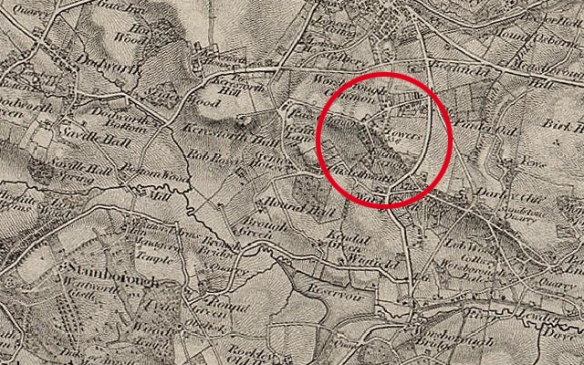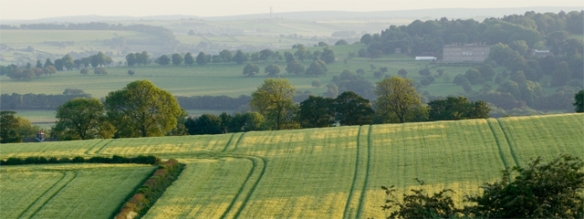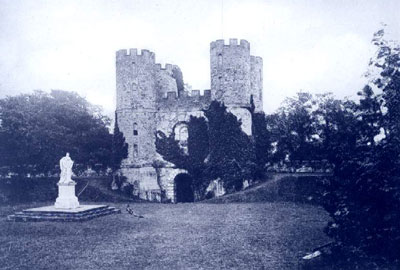When I first moved to Barnsley in 2004, I was keen to discover the history of the area that I was moving to. A quick search on the brilliant megalithic.co.uk website lead me to an entry on Pastscape detailing that an Iron Age Hillfort had occupied the very hilltop on which I live in Worsbrough Common.
Although this was exciting, searches on the ground soon confirmed that nothing seemed to remain. Unlike the nearby hilltop at Stainborough, which still bears the ditches of its hillfort, Worsbrough Common has a large council estate built in the 1950s. It is likely that this swept away any traces that might have remained. The highest point of Worsbrough Common is still tantalisingly marked as ‘Castle Hill’ on OS maps. At first I thought that this might be the only trace of the hillfort that remained, but I was to find out that it came by its name for a different reason.
Although it seems that the hillfort is probably lost, Worsbrough has a fascinating history that has largely been preserved by the good fortune of being located on the edge of Barnsley. During my research into the hillfort, I came across an ancient tome ‘Worsbrough: Its Historical Associations and Rural Attractions’ by Joseph Wilkinson, published in 1872. Among its illustrations is an etching plate, dating from 1779 of Worsbrough Common (below) which piqued my interest.
“The towers and trees which once stood here gave an air of antiquity and romance to the place, and the observer on contemplating from a distance their fortification-like aspect, was carried back in thought to the days of chivalry and warfare.”
Joseph Wilkinson, Worsbrough: Its Historical Associations and Rural Attractions.
The etching depicts a view across Worsbrough Common, with the Highstone (Black Rock) in the foreground and the hilltop horizon dominated by a line of castellations and towers. Although the drawing doesn’t accurately match the topography of the landscape, the drawing could have been made from memory and a certain amount of artistic license allowed, the track could correspond to the current position of Mount Vernon Road, which would place the castellations on the skyline running from Kingwell Lane, past what is now Mount Vernon Hospital, towards Black Rock and Castle Hill. As the area is now heavily built over, I considered that all trace of the castellations would now be lost. Especially as the towers have not been included on the OS map of the area, from the 1850 edition onwards, but were included on Castle Hill on the first issue OS map of the area, dated 1841.
I was delighted to hear from a local source that two of the towers still survive in Kingwell Woods. In fact there is a local tale that the woods are haunted by a Blue Lady dating from the Civil War, who died by falling down and abandoned mine shaft or tunnel in the area. It didn’t take me long before I went to have a look.
Kingwell Woods is a forlorn place. A narrow strip of land on a steep bank between Elmhirst Farm and Kingwell Road, it feels like a forgotten corner of Barnsley. One of the towers is easy to find, perched high on the bank, surrounded by thick woodland, it can be seen from the road once you know where to look. It is in a sad state, perched partly on natural rock outcrops, it still has bits of walling adjoining it and the remains of stone steps leading up the steep bank. Looking like it is used as a drinking den, empty cans and the remains of a fire litter the interior.
The second tower is proving a bit more elusive. I headed down into the woods, but after a couple of hundred yards wading through tangles of brambles and ivy while carrying a heavy tripod, I turned back before I met the same fate as the Blue Lady. There were scatters of what could be drystone rubble, but nothing identifiable (there was a pinfold in this area that may also add to the confusion). The woods are so densely overgrown that I may have walked right past it. So that is another adventure for another day. Probably once some vegetation has died back in the winter and without heavy camera gear.
How did these towers come to be on a hillside in Barnsley? There was certainly no castle here throughout the medieval period and the construction is definitely not in the same fashion as medieval fortifications. The answer lies in an 18th century local family feud that came to rest on the hill on the opposite side of Dove Valley, known now as Wentworth Castle.
When the second Earl of Strafford died childless in 1695, Thomas Wentworth (1672-1739) expected to inherit the estate at Wentworth Woodhouse. However, the estate was unexpectedly passed to his cousin, Thomas Watson. In 1708, he purchased the estate of Stainborough Hall from the Cutler family and began creating an estate to rival that at Wentworth Woodhouse, changing the name to Stainborough Castle. A new Barque wing was completed in 1715 and in 1731, Thomas completed a mock castle behind the house on the hill top that was the site of the previously mentioned hillfort. He then changed the name to Wentworth Castle.
William Wentworth (1722-1791) succeeded his father in 1739 and inherited his father’s appetite for building, adding another wing to the house. The 18th century was a period with a taste for follies, usually along classical lines, they were almost always of a romantic nature. Wentworth Castle certainly has classical follies, but there was another agenda at play here.
The Wentworths were engaged in a show of one-upmanship with their relatives at Wentworth Woodhouse and what better way to promote your estate from that of a country house, than to declare it a castle of ancient origin. The estate was much larger than it is today and included the hillside of Worsbrough Common, which is clearly visible from Wentworth and a line of castellations would have looked magnificent from the grounds of the house (especially with the sun rising above them). Along with the folly on top of the hill at Stainborough Castle, it would also have given the landscape a feeling of ancient continuity.
So what date could we attach to the building of the towers on Worsbrough Common? The 1817 Enclosure Act for Worsbrough Common gives us the following information.
“Enacted that all the Castle-ruins, and Ornamental Buildings which have formerly been erected by William Earl of Strafford, or any of his ancestors, upon the said Commons, shall, with the ground whereupon the same do stand, at all times hereafter be deemed the property of F.W.T.V. Wentworth, &c., with liberty to repair, support, and rebuild the same, and for that purpose to carry materials through and over the allotments adjoining to the said Castle-ruins, and Ornamental Buildings.”1
This seems to confirm that the towers were certainly the work of either Thomas Wentworth or his son William. If built by Thomas, they could have been constructed at the same time as the Stainborough Castle folly, around 1731. The tower in Kingwell Woods is similar in appearance to those that rise above the folly entrance.
Another clue could be the date carved into Black Rock. It is said that the Earl of Strafford thought that the rock was hollow and intended to convert it into a summer house. This would explain the three arched doorways carved into the rock face. That date carved above the central arch is 1756, which places it firmly in the time of William Wentworth. William certainly had a taste for building follies and built the Corinthian Temple and Rotunda, which stand in the current parkland around Wentworth Castle, Archer’s Gate, Strafford Gate, Serpentine Bridge, the Obelisk at Birdwell and possibly the now lost pyramid at Blacker Hill, known as the Smoothing Iron.
The likely conclusion is that the Worsbrough Common towers were constructed at some time between 1731 and 1756. It is possible that they are contemporary with Stainborough Castle folly, but given William’s passion for folly building and that he was responsible for the masonry work on Black Rock, this could well point to him also being the builder of the Worsbrough Common towers.
It is a great shame that what remains of the towers that once dominated the Worsbrough skyline are now forgotten and in such a state of disrepair. Especially given that Wentworth Castle park has been so spectacularly restored of late. Perhaps a little bit of care and attention is over-due for this little piece of Barnsley heritage.
- Worsbrough: Its Historical Associations and Rural Attractions. Joseph Wilkinson (1872).







Fantastic! A great detective story – thanks for sharing 🙂
Great local history,. We will be heading up there on a mini adventure soon. Thankyou xx
If you go down into the wooded area below the towers you will fin some mysterious steps going down into the ground, they are filled with very large rocks making it impossible to go down, when I was young I was told that they are supposed to go into a tunnel which leads to Stainbrough Castle, not sure how true this is.
Remnants of the second tower were still there in the 80’s. There were two tunnels that were blocked
Went through these woods as a kid in the 70’s.It scared me then and it fascinates me now. I recall the steps mentioned above regarding the tunnels.Even in my twenties walking from Sheffield Rd to Ward Green scared me.It always felt like you were being watched
Lived up Bruce avenue for years until I married in 1971, used to play on the black rock but never knew the history, thank you for sharing
I am 49 years old and from worsborough common I find it that some one like you can give ,the people of worsborough common such information like this is amazing.thank you
There are three castles, one resides in a back garden. The first castle pic is the middle one
I can remember visiting the towers on a school outing and visiting rockly farm where we we’re shown some items of clothing and shoes found in the cellar we were learning about round heads and cavaliers so I always have a look at the towers if I am passing
Have you considered a connection with the tower at Hound Hill near the Elmhirst property?
Fascinating story. Would make a great talk and slide presentation to local groups.
My father (born 1912) in Worsbrough Bridge often talked of the towers, steps and tunnel, which he claimed went all the way to Stainbrough and Wentworth Castle. Apparently during WWII the local group of signallers used to go up there, as they could get a better radio signal using their crude crystal radio sets and could secrete away their equipment to save them carrying it up and down the hill.
I grew up just round the corner on Shield Avenue and had many adventures clambering around Kingwell Woods. I’m now an archaeologist living and working in York and have always meant to look into the history of these structures, it’s fantastic to read the fruits of your research. The towers were always a fascination of mine as a kid and a recent look around was a little disappointing as I spotted 19th century brickwork within the structure (my childhood self had hoped that they were medieval!). That said, this probably relates to a bit of repair work. I wonder if the owners would be interested in some form of community archaeology project at some point…
Thank you for posting such an interesting article.
Arran- I’d be interested in joining you if this ever happened. I was with Barnsley Archaeology group many years ago (worked on the Mill of the Black Monks). This has fascinated me since I moved into our house very close to Black Rock 17 years ago. A look into the tunnels would be exciting!
Wouldn’t it just! My company does a fair bit of work in South Yorkshire, I keep hoping to get dispatched to Worsbrough at some point.
The site seems ripe for a community archaeology project of some kind. Even just cleaning up the towers and improving access would be a start. I’ll have to see what local groups are active in the area these days.
When I was a child in the 1970s, there were rocky outcrops in the grounds of the school. We used to play on them all the time. There was a steep slope down to Black Rock and a gap in the bushes that very much resembled the trackway in the etching.
In the summer, we were allowed to play in the bushes and on Black Rock. It smelled of fennel. I know now that the fennel was probably the 2nd Earl’s attempt to recreate the ruins of a Tuscan hillfort, the kind he and his wife saw on their honeymoon in Italy.
Pingback: Wentworth Castle – the feud continued | The Gardens Trust
Pingback: Wentworth Castle – Ghost of a Landscape | andyhemingway
This is a great bit of research and an important discovery of a folly that has long been thought to have been completely lost – one admired by Horace Walpole as “the ruins of a large imaginary city”.
It’s not recorded in the South Yorkshire Historic Environment Record, and it really should be.
Thanks for our local history I was born in Worsbrough and we played in the castles /follies as children and I lived on Kingwell opposite for many years the follies are part of our heritage. Beautiful area full of history
Christine Morris/Wright
Thanks for our local history always a pleasure to read /view played there as a child and lived on Kingwell for 18 years x
I lived on Ridgewalk Way 1983 to 1990. At that time the black rock wasn’t enclosed like it is now. As a kid I walked up towards the front, round the sides and climbed on it. There was loads of graffiti on it including a skull and the local kids said if you stood on it at midnight you’d go down into the rock!! I assumed the date on the front was when it was built. Are you saying that’s not right? I couldn’t quite tell from the post. Shortly before we moved away in 1990 the owner of the then bungalow to the left as you face it bought the land in front and hemmed it in. We all assumed they were sick of the kids who played on it. It was sandblasted on the front. It used to be very black. We all played on it, climbed it, chatted, told horror stories on it and fended off attacks from Worsbrough Common kids from it! Great memories! Always wondered who built it and why.
Absolutely fantastic stories and history. I worked at the house left of black rock and was fascinated by it all. I’m a Kingstone born Worsbrough common lad started off researching st Edwards church and decided to try WC. I went to see the towers at kingwell looking to see if blue lady was around.
Andy, very informative, thank you. There is also a tower in the trees on the side of the hill on the left, on Kingwell Road as you go away from Ward Green. In addition I believe there are the base remains of one tower in Worsbrough Common Primary school grounds.
Hi Andy – I came across your article whilst following up a reference in another book by Joseph Wilkinson which I have just purchased. The book is called Stainborough & Rockley Their Historical Associations and Rural Attractions. The reference mentioned the folly castle ruins at Stainborough it states that – It was erected some little time before, or about the same date, as the ruins on Worsbrough Common; and appears to have been intended like them, “for ornament not use.” I lived on Worsbrough Common from 1945 – 65. Like many people who have contributed, I also played on the black rock an fought over it with the “Ward Greeners”. I was lucky in that I had a ‘safe pass’ through Ward Green because my grandmother and cousin lived there. I remember some dilapidated brickwork on the ridge behind the black rock but can never remember a building. I never saw the towers in Kingwell Wood because it was out of bounds to us. Stainborough & Rockley was my playground during the 60’s so I new the area like the back of my hand. My book is dated 1853.
Keep up the good work